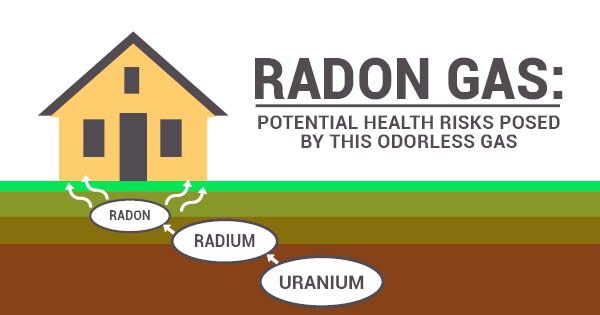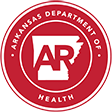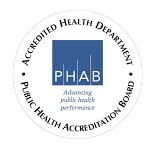Radon Gas

What is Radon?
Radon is a radioactive gas that is odorless, colorless, and tasteless. It occurs in nature and is one environmental hazard that is not caused by human activity. Radon comes from the natural breakdown (radioactive decay) of uranium, which can be found in nearly all soils and rocks. Because radon is a gas, it moves through the ground and seeps into a home through cracks or other openings in the floor and foundation.
In the outdoor air, radon is diluted to such low concentrations that it is usually nothing to worry about. However, once inside an enclosed space (such as a home) radon can accumulate. Indoor levels depend on many factors including how the building is constructed, the severity of the stack effect created by indoor-outdoor temperature differences, and the concentration (or amount) of radon in the underlying soil. The amount of radon in the air is normally measured in picocuries per liter of air (pCi/L).
Why do we care about Radon?
Radon exposure is the leading cause of lung cancer in non-smokers and the second leading cause of lung cancer in all individuals. Radon is estimated to cause over 21,000 lung cancer deaths per year nationwide – more than drunk driving, falls in the home, drownings, or home fires. Although lung cancer can be treated, the survival rate is one of the lowest for those with cancer. From the time of diagnosis, between 11 and 15 percent of those afflicted will live beyond five years, depending upon demographic factors. The lifetime lung cancer mortality risk for radon in indoor air at 4 pCi/L (the U.S. Environmental Protection Agency’s recommended action level) is 7 in 1,000 for those who have never smoked and 62 in 1,000 for smokers. Mortality risk for lung cancer increases with higher concentrations of radon gas and increased length of exposure.
What should we do about Radon?
You should test the radon level in your home regardless of where you live. You can test your own home simply and inexpensively with a test kit from a local hardware store.
Homes with radon levels at 4 pCi/L or higher should be mitigated [process to remove or lower the radon levels]. Radon levels less than 4 pCi/L still pose some risk and, in many cases, may be reduced. The U.S. EPA recommends that you also consider reducing radon gas levels in your home if it tests between 2 and 4 pCi/L.
Training Opportunities
Our U.S. EPA Regional Radon Training Center Partner, Kansas State University, provides online and in-person training courses. Training information may also be found on the websites of the two national certification programs that certify professionals to perform measurement and/or mitigation of radon. The programs are the Association of Radon Scientists and Technologists – National Radon Proficiency Program (NRPP) and the National Radon Safety Board (NRSB).
Resources
- American Lung Association
- ANSI/AARST National Radon Consensus Standards
- Arkansas Geological Survey
- Arkansas Radon Map
- EPA Radon
- EPA and other partners – National Radon Action Plan
Videos:
| Downloads | |
| Radon FAQS | |
| Radon in Schools and Child Care Facilities | |
| Radon Information Sheet | |
| Radon Program Summary: English | Spanish | |
| Radon Testing Checklist | |
| Reducing the Risk from Radon: Information and Interventions, A Guide for Health Care Providers: English | Spanish |
| Office | Address | Phone | Fax | |
| Environmental Epidemiology | 4815 W. Markham, Slot 32 Little Rock, AR 72205 |
501-661-2232 | 501-280-4090 | ADH.EPI.Radon@arkansas.gov |


